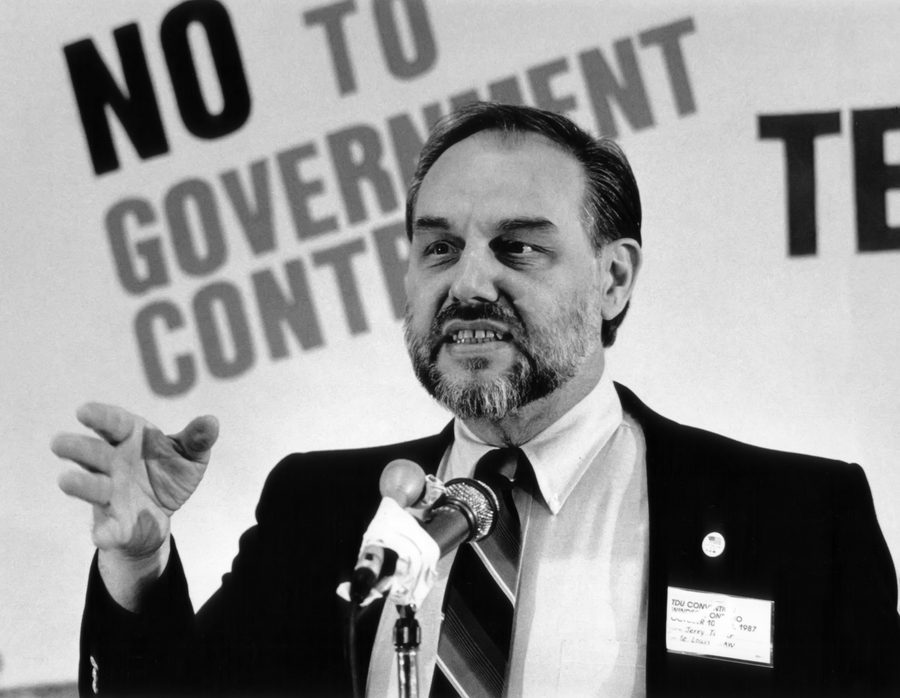Before Shawn Fain, There Was Jerry Tucker
Tucker, a UAW member and union leader, called for a union in solidarity with its workers, not businesses.
In These Times Editors

In March, the United Auto Workers voted out its Administrative Caucus leadership, ending a 77-year dynasty superseded by a fighting reform caucus.
In 1992, John E. Borsos wrote about another UAW reform movement, ultimately unsuccessful, with the campaign of Jerry Tucker, who voiced frustration at the union’s seeming unwillingness to fight for better contracts.
Today, UAW President Shawn Fain is pushing an unprecedented list of demands to the Big Three automakers and leveraging a massive strike. Borsos’ now 30-year-old claim — that only new, progressive leadership could recenter the UAW around the militant solidarity it was founded to achieve — is finally being tested.
In 1992, John E. Borsos wrote:
In December, General Motors boldly announced its plans to cut its American workforce by more than 70,000 people, touching off a flurry of editorials, news articles and television stories. Remarkably, amid all the recent controversy regarding the auto industry, the once-powerful United Auto Workers (UAW) and its president, Owen Bieber, have been noticeably silent in the escalating national dialogue.
Ironically, GM Chairman Robert Stempel was one of the very few who expressed concern with the role of the UAW in the automaker’s future. When he announced the dramatic cutbacks, Stempel said he wanted to work with the current UAW leadership — Owen Bieber and the head of the union’s GM department, Steve Yokich. This off-hand remark — a corporate executive expressing his preference of union leadership — should have set bells ringing among rank-and-file UAW members, particularly when the downsizing announcement elicited little protest from Solidarity House, the UAW’s international headquarters. The announcement was especially disastrous for GM’s hourly employees since the company’s failure to designate which of the 21 plants it plans to shut down is sure to instigate intraunion competition as locals offer concessions and enhanced productivity to ensure that theirs is not the plant hit.
Stempel’s approval expresses how completely the UAW is now willing to accept whatever scraps management throws its way. It also helps to explain why the national media has found it unnecessary to talk to the head of the UAW: There is virtually no difference between the corporate and business union agendas. But the failure of the alternative press, including In These Times (David Moberg, “Can Detroit overcome its car sickness?” Jan. 22) to consider the role of the union is puzzling, considering that for the first time in more than 40 years, the presidency of the UAW is being openly challenged in a national campaign, making it necessary, in Stempel’s estimation, for him to declare his preference.
A fresh perspective: The alternative is Jerry Tucker, an avowed progressive. Seemingly, the ’90s are a decade ripe for union insurgents. In 1990. Ken Coss won the presidency of the United Rubber Workers on a platform opposed to the concessionary tactics of his predecessor Milan Stone. Last December. Ron Carey dramatically captured the Teamsters’ presidency. If reformers could win the Teamsters, then perhaps no union was invulnerable. But where Coss and Carey are committed to winning better contracts and benefits, Tucker’s candidacy, as part of the New Directions Caucus, offers a fresh perspective to the contemporary debate. Where others, in knee-jerk fashion, join in Iacocca-esque Japan bashing, New Directions centers its blame on those most responsible for the plight of the” auto industry — the corporations themselves.
Speaking to a group of autoworkers in Cleveland after he formally announced his candidacy for the UAW presidency on January 31, Tucker squarely focused the blame: “The Big Three, GM especially, didn’t want to compete for the small-car market because there is more money to be made in building bigger cars. They don’t really build cars — they make profits.” Through the 70s, this was less of a problem as the small-car market remained small. But more recently, the implications of the Big Three’s myopia has proved too damaging for the domestic auto industry as American consumers have clearly indicated their preference for fuel-efficient, safe, well-engineered cars.
Unfortunately for autoworkers, the once-militant UAW has capitulated to the corporate agenda. Where the union once pushed the industry to build safer and more fuel-efficient cars, it now joins corporate efforts to lobby Congress to relax fuel standards, pollution emissions and other regulations that business leaders say inhibit competitiveness and cost jobs.
“That’s crazy,” Tucker says. “If you force the corporations to build safer cars, you save jobs.” Lost in the rhetoric, Tucker points out, is the fact that the Japanese are able to produce such vehicles. And, according to Tucker, those who say that American autoworkers are lazy and ignorant are just plain wrong. It’s the cozy relationship between the company and the union that has immobilized the UAW, leaving it unable to pose an alternative to the corporate agenda, Tucker says.
Characteristically, the New Directions agenda is an end to the labor-management “jointness” programs. Rather than make workers more competitive, contends Tucker, it “makes people afraid and atomized. People are afraid that they’ll lose their jobs, and the union played a part in that.” It is no revelation that the auto industry has been ailing lately, but it is often overlooked that the costs have been borne largely by the hourly workforce.
Despite concession bargaining and “jointness” programs, the number of hourly workers continues to dwindle. UAW membership has fallen from 1.4 million in 1979 to 930,000 today. Contract provisions that preclude closing plants during the life of a collective-bargaining agreement are ignored, work rules are renegotiated and plants are pitted against each other to retain the decreasing number of jobs. And, contrary to its progressive past and its prominent role in the American labor movement, the leadership of the UAW seems to be doing nothing to turn this situation around. This has been the impetus for the creation of the New Directions Caucus and Tucker’s candidacy. In the past, Tucker says, “the union didn’t win them all, but they fought most of them.”
Fighting back: Jerry Tucker, now 53, began his UAW career as an hourly worker at the GM Assembly in St. Louis. Holding a variety of local union offices, he was appointed by Walter Reuther to the UAW international staff in 1970. By the late 70s, he was the UAW’s Washington legislative coordinator. In 1980, he returned to the St. Louis district to become a service representative and assistant regional director in UAW Region 5.
In that capacity, Tucker drew notice for initiating a series of innovative workplace strategies that enabled rank-and-file workers successfully to challenge concessionary contracts without having to strike. The linchpin of Tucker’s strategies was “working to rule,” in which workers performed their jobs just as their work manuals and job descriptions prescribed them to be carried out rather than utilizing the shortcuts workers naturally develop on the shop floor.
Significantly, Tucker’s successes in fighting concessions, especially in the aerospace industry, occurred as the international union was giving away the store to the car companies. Initially, Tucker believed concessions “were a strategic retreat,” a device for the union to catch its breath before once again taking on the companies. But by the mid-’80s, he and others came to believe that the union lacked a constructive policy. In 1986, Tucker was drafted to run as director of UAW Region 5, where he was declared defeated in a controversial election marred by numerous discrepancies. Taking his case to the Department of Labor, after a two-year court battle Tucker was installed as the Region 5 director, just a few months before the term was to expire. In 1989, he campaigned for re-election and was defeated after intense politicking by the administration caucus, which pressured each of the nearly 800 UAW staff members to contribute $500 to defeat Tucker.
Following Tucker’s defeat, New Directions organized in 1989 as a national movement and Tucker was elected its national organizer. In November, the national New Directions Movement ratified a 1992 convention platform and drafted Tucker to run for the international presidency. Since its founding in 1989, the New Directions Movement has achieved a following in every UAW region in the country. Among the movement’s most vocal supporters has been Victor Reuther, who urged the running of an opposition candidate to get the issues into public debate. Unlike many reform candidacies in which the office seekers’ primary campaign message has been to do a better job than his opponent or to clean up shop, Tucker’s is an issues-oriented campaign.
The New Directions 1992 platform has five main points: internal democratization and reform; more equitable collective bargaining; organizing the unorganized; political relationships and the UAW’s relationship to other unions and community allies; international labor solidarity.
The most important is democratization and reform. Using the Teamsters’ effort as a model, New Directions is demanding a one-person, one-vote structure for the international. At present, rank-and-file members elect delegates who then vote for the president at the national election. New Directions proposes referendum balloting by the entire membership for all members of the international executive board. It also advocates electronic voting by delegates at the national conventions to make roll-call voting more readily accessible and as a way to ensure delegates’ accountability to their constituents in the shop. At present, according to Tucker, the UAW “is a one-party state.” As one New Directions pamphlet states it, “Russian citizens can have glasnost and perestroika and new freedoms — why can’t UAW members?”
A new vision: Tucker and New Directions are most significant in that they promise to re-establish labor as a major force of social change. “We are offering,” Tucker writes, “a new vision of democratic unionism for the ’90s and into the 21st century based on solidarity among workers, not with bosses.” This vision includes both solidarity with other international labor organizations and with preexisting community groups here in the U.S., particularly with environmental activists. New Directions is firmly committed to national health insurance and is exploring the possibility of independent political action. As Tucker told the Cleveland autoworkers, “I view unionism as community. It provides a source of solidarity and community.”
Undoubtedly, a candidate running on such a platform faces an uphill fight in a less-than-democratic union election. Like Carey’s candidacy in the Teamsters, New Directions faces the challenge of getting its message out to rank-and-file workers in the shops who may be unaware of Tucker’s challenge. This task has recently been made more difficult as many local unions have stepped up the date by several weeks of their elections of delegates to the national convention. Traditionally, these elections were held in April or May, before the June convention. This year, some are being held this month.
Concluding his campaign talk in Cleveland, Tucker observed, “It won’t bother me a whole lot if I never win another election in the UAW. But it will bother me if the membership doesn’t stand up for their union.






